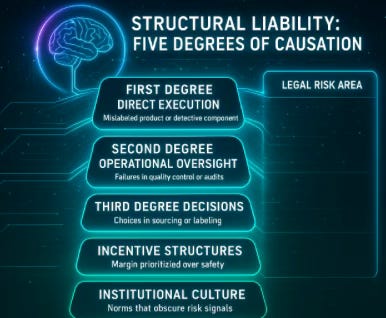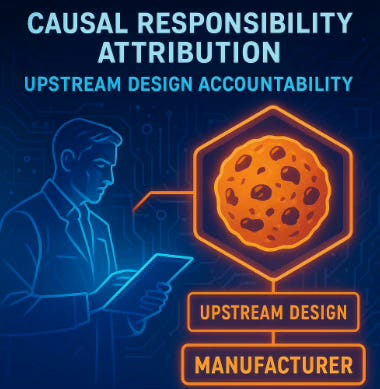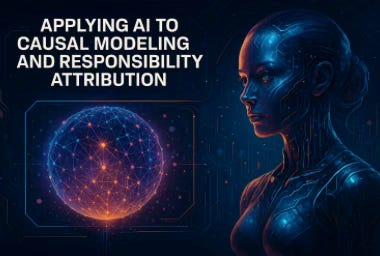MCAI Lex: Causal Responsibility Attribution, Two Sides of the Private Label Coin
A Framework for Structural Foresight, Legal Accountability, and Consumer Protection
Causal Vision and the Shift from Blame to Foresight
Mindcast AI's Causal Responsibility Attribution (CRA) offers a structural approach to liability across modern supply chains. "Two Sides of the Private Label Coin" highlights two key actors—private labels and manufacturers—who share responsibility for the safety and trustworthiness of consumer products. TheCRA model leverages advanced AI foresight to reveal where preventable harm begins and how institutional decisions propagate downstream risk.
For consumers, CRA represents more than a legal tool—it provides defense at the point of risk. When the structure behind a brand fails, the consequences can be fatal, as tragically illustrated in a recent Washington case where a mislabeled cookie sold under Safeway’s brand caused a fatal allergic reaction. (Read the KING5 article) CRA helps surface not only who failed, but how harm could have been averted.
Tort law often applies the Hand formula to assess negligence. Under this model—B < PL—a party is liable if the burden (B) of preventing harm is less than the probability (P) of harm occurring multiplied by the loss (L) that would result. Yet this formula hinges on what courts consider foreseeable. If a risk lies beyond the first or second degree of causation, the burden is often ignored—even when prevention would have been simple.
Mindcast AI enables deeper insight through AI-powered causation modeling tools. The system includes Cognitive Digital Twins (CDTs), foresight signal mapping, and real-time risk forecasting engines—all working together to identify embedded vulnerabilities before harm occurs. MCAI operationalizes CRA through structured modeling, giving institutions a clear view of who could have acted—and when.
Mindcast AI's Causation Vision reconfigures the legal framework by tracing harm through five structural degrees of causation:
First Degree – Direct Execution
The most immediate action—such as a mislabeled product or defective component. Tort law routinely stops here.Second Degree – Operational Oversight
Failures in quality control, audits, or compliance enforcement that allow known risks to pass uncorrected.Third Degree – Design-Level Decisions
Choices in sourcing, vendor approval, or labeling conventions that shape risk long before harm appears.Fourth Degree – Incentive Structures
Internal systems that reward margin or speed over safety or foresight. These often distort decision-making beneath the surface.Fifth Degree – Institutional Culture
The ethical posture of an organization—norms that suppress escalation, limit accountability, or obscure risk signals entirely.
By identifying these layers, CRA supports risk prevention that is measurable, traceable, and, above all, actionable.
I. Private Labels — Front-Facing Trust, Embedded Responsibility
In a real-world case, a peanut butter cookie was sold under Safeway’s private label, but labeled as an oatmeal raisin cookie—with no allergen warning. A woman with a known peanut allergy ate the cookie and later died from anaphylactic shock. The product was traced back to Safeway’s store, and the mislabeling prompted a recall and a wrongful death lawsuit. The failure was not technical alone—it was structural.
Tort law would likely draw the line of legal obligation at the second degree—direct execution and operational oversight. Courts may hold Safeway liable for the mislabel and its failure to audit the vendor but often decline to examine deeper causes such as supplier selection, internal incentives, or brand governance. However, if litigation uncovers recurring patterns—like repeated audit lapses or ignored warnings—then what was once unforeseeable becomes structurally obvious. The legal system then shifts.
Under the Hand formula, the burden of requiring allergen labeling or basic packaging checks is minimal—compared to the probability of harm and potential loss. CRA helps institutions recognize when structural risk outweighs short-term convenience.
CRA layers in this example:
First Degree: Mislabeled packaging that led to a fatal allergic reaction.
Second Degree: Failure to audit allergen segregation or final labeling.
Third Degree: Choice to source from a supplier handling high-risk ingredients without requiring special labeling.
Fourth Degree: Incentives to prioritize volume or presentation over traceability.
Fifth Degree: A brand culture that delegated responsibility without integrated foresight systems.
For the consumer, the label represented safety. CRA reveals whether that trust was earned or simply assumed.
II. Manufacturers — Upstream Influence, Delimited Accountability
Now consider the manufacturer’s role. Imagine a supplier that produces visually similar oatmeal raisin and peanut butter cookies, and delivers them in bulk to multiple retailers. One retailer repackages the cookies under a private label—without a clear allergen warning. A mislabeled cookie leads to fatal harm.
From a tort standpoint, the court may evaluate whether the manufacturer followed specs and conducted basic product safety checks. But it may not consider design-level confusion or ingredient warnings foreseeable unless prior incidents exist. If a root cause emerges during litigation—such as repeated confusion over product similarity—then the foreseeability threshold evolves.
The Hand formula suggests that identifying and labeling visually similar high-allergen items involves minimal burden. CRA reveals that ignoring this burden—especially when manufacturing both products on shared lines—is a structural flaw.
CRA layers in this example:
First Degree: Manufactured product contained allergen.
Second Degree: Safety reviews and documentation failed to flag a foreseeable hazard.
Third Degree: The product was designed without strong visual or packaging differentiation.
Fourth Degree: Cost and process simplicity were prioritized over user safety.
Fifth Degree: A risk culture that relied on retailers to catch problems rather than proactively surfacing design limitations.
From the public’s view, brand or vendor distinctions don’t matter. What matters is safety. CRA ensures upstream actors do more than comply—they anticipate.
III. Expanding Foreseeability: Legal Frameworks vs. CRA Insight
Traditional tort law uses several frameworks to define foreseeability and allocate liability. These help ensure fairness and manageable scope—but they often miss systemic signals. CRA expands and strengthens these models through structural insight:
Hand Formula (B < PL): A basic cost-benefit test that breaks down if foreseeability is truncated too early. CRA tracks when the burden is low, but dismissed prematurely.
Wagon Mound Test: Restricts liability to "reasonably foreseeable" harms. CRA reframes what’s reasonable by showing how "remote" outcomes are often structurally embedded.
Zone of Danger (Palsgraf): Limits duty to those clearly within risk proximity. CRA expands this view based on systems design, not just physical or intuitive closeness.
Restatement (Third): Ties liability to the scope of the risk that made the conduct negligent. CRA shows how this scope widens once structural context is understood.
Eggshell Plaintiff Rule: Holds defendants liable for full harm, even if the victim is unusually vulnerable. CRA supports this by identifying when products interact disproportionately with high-risk populations—making latent hazards visible.
Together, these legal frameworks reflect evolving thresholds of accountability. CRA ensures those thresholds shift forward, not backward, in response to what systems could—and should—have foreseen.
IV. MCAI’s Technical Stack in Action
Mindcast AI operationalizes CRA through core technologies:
Cognitive Digital Twins (CDTs): Simulate internal decision-makers—like brand managers or safety directors—highlighting where judgment failed or foresight was deferred.
Risk Forecasting Engine: Detects future structural breakdowns before public harm. Tracks when foreseeable harm emerges systemically, even if it hasn’t occurred yet.
Foresight Signal Modeling: Measures how institutions transmit or suppress risk-relevant information across their workflows—critical for surfacing 4th- and 5th-degree failures.
These systems make CRA executable in real time. They help brands and manufacturers see what traditional audits miss—before consumers pay the price.
V. Conclusion
Private labels and manufacturers represent two ends of a shared risk spectrum. One controls the signal; the other sets the structure. CRA links them with clarity.
Mindcast AI doesn’t wait for lawsuits to reveal failure—it equips institutions to recognize preventable harm before it materializes. For the public, that’s not just a better system—it’s a safer world.
Prepared by Noel Le, Founder | Architect of MindCast AI LLC. Noel holds a background in law and economics. noel@mindcast-ai.com







